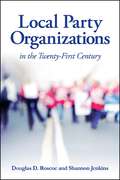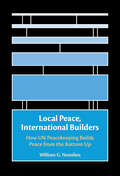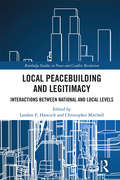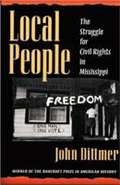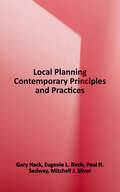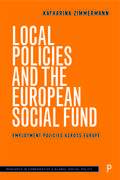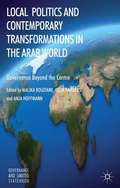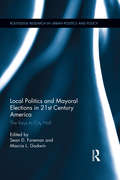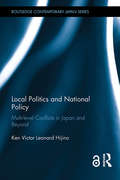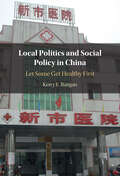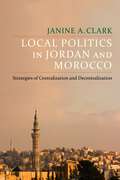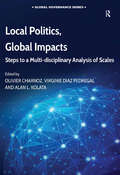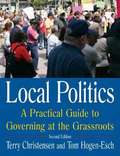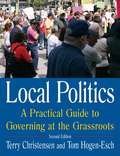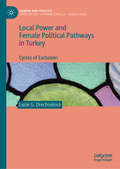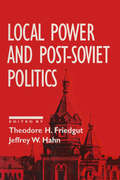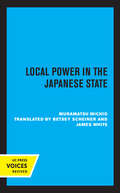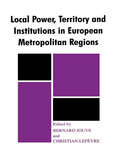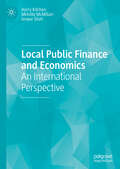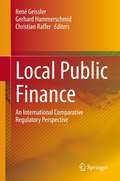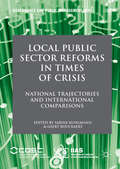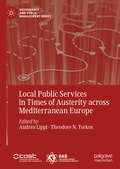- Table View
- List View
Local Party Organizations in the Twenty-First Century
by Shannon Jenkins Douglas D. RoscoeWhile the media pay the most attention to the actions of the national political committees, political scientists have long emphasized the key role of local party organizations. Despite sweeping changes in the political environment, remarkably little research has sought to understand precisely how these local parties are structured, what they do, and whether they have any impact on the political system. In Local Party Organizations in the Twenty-First Century, Douglas D. Roscoe and Shannon Jenkins use data collected from more than 1,100 local parties in forty-eight states to provide the most thorough examination of the role of local political parties in the US political system, something that has been lacking in contemporary accounts of the role of parties. They show that party organizations take particular forms and engage in certain activities because political actors find these forms and activities useful for winning elections. While past research has centered primarily on the role of national and state political parties in the United States, this book demonstrates the continuing central role of local political parties in the electoral process, providing readers with a more comprehensive understanding of the US party system.
Local Peace, International Builders: How UN Peacekeeping Builds Peace from the Bottom Up
by William G. NomikosCommunal disputes over local issues such as land use, cattle herding, and access to scarce resources are a leading cause of conflict across the world. In the coming decades, climate change, forced migration, and violent extremism will exacerbate such disputes in places that are ill equipped to handle them. Local Peace, International Builders examines the conditions under which international interventions mitigate communal violence. The book argues that civilian perceptions of impartiality, driven primarily by the legacies of colonialism, shape interveners' ability to manage local disputes. Drawing on georeferenced data on the deployment of over 100,000 UN peacekeepers to fragile settings in the 21st century as well as a multimethod study of intervention in Mali – where widespread violence is managed by the international community – this book highlights a critical pathway through which interventions can maintain order in the international system. This title is also available as Open Access on Cambridge Core.
Local Peacebuilding and Legitimacy: Interactions between National and Local Levels (Routledge Studies in Peace and Conflict Resolution)
by Christopher Mitchell Landon E. HancockThis volume searches for pragmatic answers to the problems that continue to beset peacebuilding efforts at all levels of society, with a singular focus on the role of legitimacy. <P><P>Many peacebuilding efforts are hampered by their inability to gain the support of those they are trying to help at the local level, or those at regional, national or international levels; whose support is necessary either for success at the local level or to translate local successes to wider arenas. There is no one agreed-upon reason for the difficulty in translating peacebuilding from one arena of action to another, but among those elements that have been studied, one that appears understudied or assumed to be unimportant, is the role of legitimacy. Many questions can be asked about legitimacy as a concept, and this volume addresses these questions through multiple case studies which examine legitimacy at local, regional, national and international levels, as well as looking at how legitimacy at one level either translates or fails to translate at other levels, in order to correlate the level of legitimacy with the success or failure of peacebuilding projects and programs <P><P>The value of this work lies both in the breadth of the cases and the singular focus on the role of legitimacy in peacebuilding. By focusing on this concept this volume represents an attempt to build beyond the critical peacebuilding approach of deconstructing the liberal peacebuilding paradigm to a search for pragmatic answers to the problems that continue to plague peacebuilding efforts at all levels of society. <P><P>This book will be of much interest to students of peacebuilding, conflict resolution, development studies, security studies and International Relations.
Local People: The Struggle for Civil Rights in Mississippi
by John DittmerWinner of the Bancroft Prize, the Lillian Smith Book Award, the Mississippi Historical Society McLemore Prize, the Herbert G. Gutman Prize and the Gustavus Myers Center for Study of Human Rights Outstanding Book Prize. For decades the most racially repressive state in the nation fought bitterly and violently to maintain white supremacy. John Dittmer traces the monumental battle waged by civil rights organizations and by local people, particularly courageous members of the black communities who were willing to put their lives on the line to establish basic human rights for all citizens of the state. Local People tells the whole grim story in depth for the first time, from the unsuccessful attempts of black World War II veterans to register to vote to the seating of a civil rights-oriented Mississippi delegation at the 1968 Democratic National Convention. Particularly dramatic - and heartrending - is Dittmer's account of the tumultuous decade of the sixties: the freedom rides of 1961, which resulted in the imprisonment at Parchman of dozens of participants; the violent reactions to protests in McComb and Jackson and to vote registration drives in Greenwood and other cities; the riot in Oxford when James Meredith enrolled at Ole Miss; the cowardly murder of longtime leader Medger Evers; and the brutal Klan lynchings of civil rights workers James Chaney, Michael Schwerner, and Andrew Goodman during the Freedom Summer of 1964. Dittmer looks closely at the policies and actions of the Kennedy administration, which, bowing to Mississippi's powerful senators John Stennis and James Eastland, refused to intervene even in the face of obvious collusion among local officials and vigilantes. Through oral history accounts readers will come to know many of the local people and grass-roots organizers who worked, and in some cases gave their lives, for the cause of civil rights. Among those whose stories are told are Fannie Lou Hamer, the Sunflower County sharecropper who helped found the Mississippi Freedom Democratic party; Victoria Gray and Annie Devine, who with Mrs. Hamer challenged the seating of Mississippi's congressional delegation in 1965; Bob Moses of SNCC, the most significant "outsider" in the movement; Hollis Watkins, a SNCC field secretary from southwest Mississippi; and Dave Dennis, a freedom rider from New Orleans who became CORE's Mississippi field secretary in 1962. In the final chapter, Dittmer charts the transformative strength of the Mississippi movement while pointing out the limitations of its hard-earned reforms. If black Mississippians did not achieve all their goals, he reminds us, they nonetheless managed to bring about extraordinary changes in a state that had been locked in the caste system for nearly a century. John Dittmer, a professor of history at DePauw University, Greencastle, Indiana, is the author of Black Georgia in the Progressive Era, 1900-1920. From 1967 to 1979 he taught history at Tougaloo College in Mississippi.
Local Planning: Contemporary Principles and Practice
by Eugenie L. Birch Gary Hack Paul H. Sedway Mitchell J. SilverThis all-new edition of the popular book (2000 Title-Practice of Local Government Planning, 3e) will continue to be a valued resource for preparing for the AICP exam. This new edition helps the reader understand the complexities of planning at the local level, and prepare to make decisions in a challenging environment. The eight chapters in Local Planning, roughly spanning from context to applications, consist of articles written by a wide range of expert academics, practitioners, clients, and observers of planning. Many examples of planning in action illustrate central principles.
Local Policies and the European Social Fund: Employment Policies Across Europe (Research in Comparative and Global Social Policy)
by Katharina ZimmermannThis book reviews how local social and employment policy fields react to the European Social Fund (ESF) to determine the role of the ESF in local activation policies. Drawing on both sociology and political science literature on welfare state reforms, the author examines what shapes local policy reactions to ESF and what effects these reactions have on change in local policy fields. Comparing data from 18 local case studies across 6 European countries, and deploying an innovative mixed-method approach, the book presents comparative evidence on everyday challenges in the context of the ESF and discusses how these findings are applicable to other funding schemes.
Local Politics And Development In The Middle East
by Louis J. Cantori Iliya HarikAlthough development at the local level is a primary goal of most assistance schemes, most development agencies and banks know little of politics at the local level in developing countries. As a result, assistance programs generally lack relevance to indigenous populations and are--at the community level--viewed as being controlled from the "outside." The authors of this book concentrate on how local politics influence development in the Middle East, with the intent of encouraging more appropriate--and thus more effective--assistance programs. They discuss general policy issues and the nature of center-periphery relations in Middle East countries and delve into specific problems encountered in Egypt, Jordan, Lebanon, Syria, Iraq, Turkey, Tunisia, and North Yemen, showing how information about local political schemes can aid administrators of development programs in providing assistance that is acceptable--and accepted--at the local level. The case studies provide a broad base for planning, encompassing capitalist, state capitalist, and socialist systems in both rural and urban settings.
Local Politics and Contemporary Transformations in the Arab World
by Malika Bouziane Cilja Harders Anja HoffmannThe contributors link innovative analytical concepts and ethnographic in-depth case studies from the Arab world. Based on the debates on politics from below and dynamic concepts of state, all the chapters focus on informal institutions, non-elite actors, and the dynamic and contradictory relationship between state and society.
Local Politics and Democratization in Russia (BASEES/Routledge Series on Russian and East European Studies)
by Cameron RossThis comprehensive study of local politics in Russia shows that the key reforms of local government, and the struggle to forge viable grassroots democracies have been inextricably linked to the wider struggle for power between the regions and the Kremlin, and to the specific nature of Russia’s highly politicized and negotiated form of asymmetrical federalism. During the Yeltsin era all attempts to create a universal and uniform system of local-self-government in the federation were a failure. Under the protection of their constitutions and charters, and the extra-constitutional rights and powers granted to them in special bilateral treaties, regional leaders, particularly in Russia’s 21 ethnic republics were able to instigate highly authoritarian regimes and to thwart the implementation key local government reforms. Thus, by the end of the Yeltsin era the number of municipalities, their type, status and powers, varied tremendously from region to region. Putin’s local government reforms also need to be viewed as an integral component of his wider centralizing political agenda, and his assault on the principles and practices of federalism. With the instigation of his ‘dictatorship of law’ and ‘power vertical’, Putin has thwarted the development of grassroots democracy and overseen the creation of local ‘electoral authoritarian’ regimes. Putin’s new system of local self-government marks a victory for the proponents of the ‘statist concept’ of local self-government over those who championed the ‘societal concept’, codified in Article 12 of the Russian Constitution. Overall, this book is an important resource for anyone seeking to understand politics in Putin’s Russia.
Local Politics and Mayoral Elections in 21st Century America: The Keys to City Hall (Routledge Research in Urban Politics and Policy)
by Sean D. Foreman Marcia L. GodwinSome of the most populated and storied American cities had mayoral elections in 2013. Open contests in New York City, Los Angeles and Boston, for example, offer laboratories to examine electoral trends in urban politics. Cities are facing varied predicaments. Boston was rocked by the bombing of the marathon on April 15. Detroit is roiled by being the largest U.S. city to declare bankruptcy, and Chicago, which had an open, competitive election in 2011, is dealing with significant gun violence. San Diego’s mayor resigned in August 2013 due to sexual harassment charges and other mayors are surrounded by corruption scandals. Houston and St. Louis had non-competitive elections recently but their mayors are notable for their tenure in office and emphasis will be on public policy outcomes in those cases. Leaders in most cities face dramatic changes and challenges due to economic and social realities. The Keys to City Hall offers a complete and succinct review and analysis of the top mayoral campaigns in major American cities in recent years as well as the politics and public policy management of those urban areas. Emerging theories of urban governance, demographic changes, and economic conditions are examined in introductory chapters; the introduction will provide a unique and comprehensive focus on major trends in advertisement, changes in campaign strategies, fundraising, and the use of social media at the local level. In Part Two, scholars with expertise in local politics, urban public policy, and the governance explore some of the largest and most noteworthy U.S. cities, each of which has a recent, competitive mayoral election. They will also provide updated data on mayoral powers and problems faced by local executives. Written as lively narratives in a highly readable style, this book advances theory on urban politics by reviewing developments in the field and aligning theoretical approaches with realities on the ground based on the most recent elections and governance structures. As such, it will be a much needed resource to scholars interested in local politics, and the public policy debates of specific major urban and metropolitan areas.
Local Politics and National Policy: Multi-level Conflicts in Japan and Beyond (Routledge Contemporary Japan Series)
by Ken Victor HijinoThis book is about why and how central and local governments clash over important national policy decisions. Its empirical focus is on the local politics of Japan which has significantly shaped, and been shaped by, larger developments in national politics. The book argues that since the 1990s, changes in the national political arena, fiscal and administrative decentralization, as well as broader socio-economic developments have led to a decoupling of once closely integrated national and local party systems in Japan. Such decoupling has led to a breakdown of symbiotic relations between the centre and regions. In its place are increasing strains between national and local governments leading to greater intra-party conflict, inter-governmental conflicts, and more chief executives with agendas and resources increasingly autonomous of the national ruling party. Although being a book primarily focused on the Japanese case, the study seeks to contribute to a broader understanding of how local partisans shape national policy-making. The book theorizes and investigates how the degree of state centralization, vertical integration for party organizations, and partisan congruence in different levels of government affect inter-governmental relations. Japan’s experience is compared with Germany, Canada, and the UK to explore sources of multi-level policy conflict.
Local Politics and Social Policy in China: Let Some Get Healthy First
by Kerry RatiganDue to uneven economic reforms, Chinese provinces have developed distinct approaches to governing that impact social policy priorities and policy implementation. Ratigan shows how coastal provinces tended to prioritize health and education, and developed a pragmatic policy style, which fostered innovation and professionalism in policy implementation. Meanwhile, inland provinces tended to prioritize targeted poverty alleviation and affordable housing, while taking a paternalist, top-down approach to implementation. This book provides a quantitative analysis of provincial social policy spending in the 2000s and qualitative case studies of provinces with divergent approaches to social policy. It highlights healthcare, but also draws on illustrative examples from poverty alleviation, education, and housing policy. By showing the importance of local actors in shaping social policy implementation, this book will appeal to scholars and advanced students of Chinese politics, comparative welfare studies, and comparative politics.
Local Politics in Indonesia: Pathways to Power (Routledge Contemporary Southeast Asia Series)
by Nankyung ChoiCompetitive elections have become an institutionalized feature of contemporary Indonesia’s politics. This, together with other considerations, makes it reasonable to call Indonesia the world’s third largest democracy. Nonetheless, democratic elections in Indonesia are both more complex and interesting than is commonly understood. This book explores how local elections in Indonesia have affected the development and dynamics of Indonesia’s fledgling democracy. Based on fine-grained analyses of elections in five localities, the book shows how Indonesia’s transition to direct elections of local government executives has transformed party politics and elite development at local levels of governance. Employing the methods of political anthropology and informed by a critical reading of theories of democracy and decentralization, the book presents detailed analyses of elections in five localities across four Indonesian provinces. The book calls attention to the ambiguous relation between formal democratic reforms and political behavior. It illustrates how local elite politics has evolved within the context of political and administrative reforms, whose announced goals are to improve the representativeness and responsiveness of political institutions. This book provides a window onto local political processes that will be of interest to students and scholars of politics in Southeast Asia and beyond.
Local Politics in Jordan and Morocco: Strategies of Centralization and Decentralization (Columbia Studies in Middle East Politics)
by Janine A. ClarkIn recent years, authoritarian states in the Middle East and North Africa have faced increasing international pressure to decentralize political power. Decentralization is presented as a panacea that will foster good governance and civil society, helping citizens procure basic services and fight corruption. Two of these states, Jordan and Morocco, are monarchies with elected parliaments and recent experiences of liberalization. Morocco began devolving certain responsibilities to municipal councils decades ago, while Jordan has consistently followed a path of greater centralization. Their experiences test such assumptions about the benefits of localism.Janine A. Clark examines why Morocco decentralized while Jordan did not and evaluates the impact of their divergent paths, ultimately explaining how authoritarian regimes can use decentralization reforms to consolidate power. Local Politics in Jordan and Morocco argues that decentralization is a tactic authoritarian regimes employ based on their coalition strategies to expand their base of support and strengthen patron-client ties. Clark analyzes the opportunities that decentralization presents to local actors to pursue their interests and lays out how municipal-level figures find ways to use reforms to their advantage. In Morocco, decentralization has resulted not in greater political inclusivity or improved services, but rather in the entrenchment of pro-regime elites in power. The main Islamist political party has also taken advantage of these reforms. In Jordan, decentralization would undermine the networks that benefit elites and their supporters. Based on extensive fieldwork, Local Politics in Jordan and Morocco is an important contribution to Middle East studies and political science that challenges our understanding of authoritarian regimes’ survival strategies and resilience.
Local Politics, Global Impacts: Steps to a Multi-disciplinary Analysis of Scales (Global Governance)
by Olivier Charnoz Virginie Diaz PedregalServing as a touchstone for a much-needed research program on social scales, this volume challenges disciplinary boundaries and brings into focus a paradoxical state of affairs in contemporary thought: the domain of local-global interactions has not yet been identified as an object of analysis in its own right, despite engaging a large, multi-disciplinary research community with strong potential for cross-fertilization. Bringing together internationally renowned as well as emerging scholars, this book presents concrete case studies framed by theoretical concern with the issue of scale. It demonstrates that a diverse array of theoretical, methodological and empirical perspectives can productively converge on a common set of problems related to social, temporal and spatial scales and contemporary globalization. Local Politics, Global Impacts will stimulate empirical and theoretical research that focuses on understanding how political concepts, practices, and instruments translate across scales, and contribute to the emergence of a self-aware community of scholars and practitioners focusing explicitly on modelling the dynamics of local-regional-global interactions.
Local Politics: A Practical Guide To Governing At The Grassroots
by Terry Christensen Tom Hogen-EschUnlike most competing texts that are densely written and heavily theoretical, with little flavor of political life, this book is a readable, jargon-free introduction to real-life local politics for today's students. While it encompasses local government and politics in cities and towns across America, "Local Politics: A Practical Guide to Governing at the Grassroots" gives special attention to the politics of suburbia, where many students live, and encourages them to become engaged in their own communities. The book is also distinguished by its strong emphasis on nuts-and-bolts practical politics. It provides focused discussion of institutions, roles, and personalities as well as the dynamic environment of local politics (demographics, immigration, globalization, etc.) and major policy issues (budgets, land use, transportation, education, etc.). Other texts treat communities as abstractions and readers as passive observers. "Local Politics: A Practical Guide to Governing at the Grassroots" is designed to inspire civic engagement as well as understanding. It features "In Your Community" research projects for students in every chapter along with informative tables, clear charts, essential terms, and guides to useful websites.
Local Politics: A Practical Guide to Governing at the Grassroots
by Terry Christensen Tom Hogen-EschUnlike most competing texts that are densely written and heavily theoretical, with little flavor of political life, this book is a readable, jargon-free introduction to real-life local politics for today's students. While it encompasses local government and politics in cities and towns across America, "Local Politics: A Practical Guide to Governing at the Grassroots" gives special attention to the politics of suburbia, where many students live, and encourages them to become engaged in their own communities. The book is also distinguished by its strong emphasis on nuts-and-bolts practical politics. It provides focused discussion of institutions, roles, and personalities as well as the dynamic environment of local politics (demographics, immigration, globalization, etc.) and major policy issues (budgets, land use, transportation, education, etc.). Other texts treat communities as abstractions and readers as passive observers. "Local Politics: A Practical Guide to Governing at the Grassroots" is designed to inspire civic engagement as well as understanding. It features "In Your Community" research projects for students in every chapter along with informative tables, clear charts, essential terms, and guides to useful websites.
Local Power and Female Political Pathways in Turkey: Cycles of Exclusion (Gender and Politics)
by Lucie G. DrechselováThis book explores the “Turkish paradox” – women’s lower representation in local politics than in parliament. By analyzing life stories of 200 female municipal councilors and party representatives, it offers a comprehensive assessment of what makes local politics in Turkey particularly inaccessible to women. It places women’s pathways within the cycles of exclusion, starting by political socialization, going through the candidate recruitment process and continuing after the election. The research presented here brings together gender studies and political sociology and offers novel applications of concepts including intersectionality and biographical availability. It covers all major political parties and diverse local configurations in Turkey, and reveals political strategies of women in conservative parties as well as the reasons behind the exceptionally high representation of women within the pro-Kurdish political parties. The book further sheds some light on the intricate relationship between women’s political activity and regime change in the context of democratic backsliding.
Local Power and Post-Soviet Politics (Contemporary Soviet - Post-soviet Politics Ser.)
by Jeffrey W. Hahn Theodore H. FriedgutAn analysis of local legislative and budgetary politics during the late Soviet and post-Soviet period with case studies of electoral behaviour, distribution processes, political contestation, and institutional development.
Local Power in the Japanese State
by Michio MuramatsuThis title is part of UC Press's Voices Revived program, which commemorates University of California Press’s mission to seek out and cultivate the brightest minds and give them voice, reach, and impact. Drawing on a backlist dating to 1893, Voices Revived makes high-quality, peer-reviewed scholarship accessible once again using print-on-demand technology. This title was originally published in 1997.
Local Power, Territory and Institutions in European Metropolitan Regions: In Search of Urban Gargantuas (Routledge Studies in Federalism and Decentralization #No. 6)
by Bernard Jouve Christian LefèvreA comparative analysis of eight different urban areas - Bologna, Bordeaux, Geneve-Lausanne, Lyons, Manchester, Rotterdam, Stuttgart and Torino - examining key urban issues that are high on the policy agenda of every national government.
Local Public Finance and Economics: An International Perspective
by Anwar Shah Harry Kitchen Melville McMillanGlobalization and the information revolution have highlighted the catalytic role of local governments for improving economic and social outcomes at the local level as well as growing the national economy by enhancing international competitiveness. This comprehensive account of local public finance and economics brings together principles and better practices for improving quality and access of local public services provision. The volume covers assignment of responsibilities; jurisdictional design; local service delivery; local regulation; local self-financing options such as income, sales, property and environmental taxation, user charges and fees; infrastructure finance options; and higher order government financing of local governments. The treatment is non-technical and suitable for a wide variety of audiences including scholars, instructors, students, media, policy advisers and practitioners.
Local Public Finance: An International Comparative Regulatory Perspective
by René Geissler Gerhard Hammerschmid Christian RafferThis book is based upon a comparative public administration research project, initiated by the Hertie School of Governance (Germany) and the Bertelsmann Foundation (Germany) and supported by a network of researchers from many EU countries. It analyzes both the regimes and the practices of local fiscal regulation in 21 European countries. The book brings together key findings of this research project. The regulatory discussion is not limited to the prominent issue of fiscal rules but focuses on every component of regulation. Beyond this, the book covers affiliated topics such as the impact of regulation for local governments, evolution of regulation, administrative costs and crisis prevention. The various book chapters throughout provide a broad picture of local public finance regulation in theory and in practice, using different theoretical and national lenses for the analysis. Furthermore, the authors investigate the effects of budgetary constraints and higher-level regulatory efforts on local governments and on democracy and public services in every European country. This book fills a gap with respect to the lack of discussion on local government finance from an international, comparative perspective and, in particular, the regulation of local public finance. With its mix of authors, this book will be useful for practitioners as well as for scholars and for theory-driven research.
Local Public Sector Reforms in Times of Crisis
by Sabine Kuhlmann Geert BouckaertThis book compares the trajectories and effects of localpublic sector reform in Europe and fills a research gap that hasexisted so far in comparative public administration and local governmentstudies. Based on the results of COST research entitled, 'Local Public SectorReforms: an International Comparison', this volume takes a European-scale approach,examining local government in 28 countries. Local government has been the mostseriously affected by the continuously expanding global financial crisis andausterity policies in some countries, and is experiencing a period of increasedreform activity as a result. This book considers both those local governmentswhich have adopted or moved away from New Public Management (NPM) modernizationto 'something different' (what some commentators have labelled 'post-NPM'), aswell as those which have implemented 'other-than-NPM measures', such asterritorial reforms and democratic innovations.
Local Public Services in Times of Austerity across Mediterranean Europe (Governance and Public Management)
by Andrea Lippi Theodore N. TsekosThis book provides a comparative analysis of the processes and impacts of austerity measures introduced in the field of Local Public Services (LPS) across Mediterranean Europe. The book describes and compares the trajectories of austerity, and the types of effects. It investigates how many (and what kind of) different responses were given to similar inputs and under the influence of what factors in order to understand if there are regularities in the way that the Mediterranean countries adopted and implemented the austerity measures and how these latter impacted on local government and LPS management and delivery. The book is a product of a sub network from the COST Action LocRef IS1207 and analyses seven countries (Portugal, Spain, Italy, Greece, Croatia, Cyprus and Albania).
